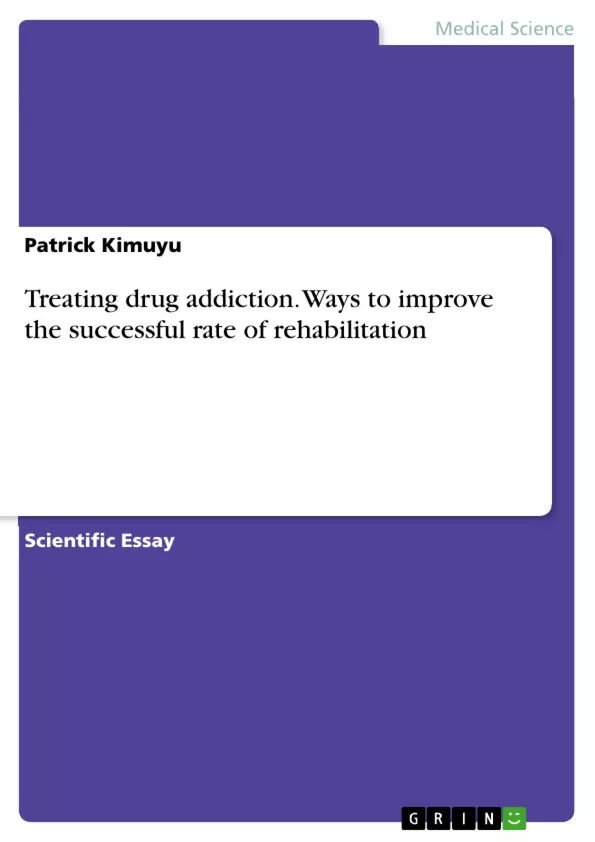Drug addiction refers to a dependence on a medication or illegal substance. Addicted people are unable to control the usage of drugs and continue using the substance despite the obvious harms associated with their behavior. Normally, drug addiction causes an intense craving for the substance making it hard for addicted people quit such behaviors.
Drug addiction causes long-term consequences such physical and mental health, strained relationships, law and employments problems. The affected persons are encouraged to inform their doctors, support groups, friends and families in order to overcome their addiction and stay safe. Some of the commonly abused drugs include; heroin, cocaine, bhang and alcohol. The treatment option for drug addiction within medical establishments depends on various factors such the type of the drug and how its affects the user.
Treatment in many medical establishments combines psychotherapy services, inpatient and outpatient programs, self-help groups and sponsors. The treatment options aim at reducing dependency and restore normal lives of addicts. Specifically, heroin addiction is caused by both social and psychological factors. For instance, unpleasant feelings, stress and pressure can contribute to heroin addiction.
According to National Institute of Drug Abuse, factors such as cultural beliefs, drug availability and lack of education deficit can also contribute to heroin addiction. In the current world, heroin addiction is treated using various drugs namely; methadone, clonidine, buprenorphine and naltrexone. This paper explores the heroin treatment methods, problems faced, the most effective method and the way to improve the successful rate of rehabilitation.
Inhaltsverzeichnis (Table of Contents)
- Heroin Addiction: Treatment and Rehabilitation
- Pharmacological Treatment Methods
- Methadone
- Naltrexone
- Buprenorphine
- Clonidine
- Motivational Interviewing
Zielsetzung und Themenschwerpunkte (Objectives and Key Themes)
This paper explores the various treatment methods for heroin addiction, focusing on their effectiveness, challenges, and strategies for improving rehabilitation success rates. It delves into the pharmacological approaches, particularly methadone, naltrexone, buprenorphine, and clonidine, analyzing their mechanisms, side effects, and comparative efficacy. The paper also highlights the role of motivational interviewing in supporting long-term recovery.
- Treatment options for heroin addiction
- Pharmacological approaches to heroin addiction
- Effectiveness of different treatment methods
- Challenges and limitations of treatment
- The role of motivational interviewing in rehabilitation
Zusammenfassung der Kapitel (Chapter Summaries)
- Heroin Addiction: Treatment and Rehabilitation
- Pharmacological Treatment Methods
- Methadone
- Naltrexone
- Buprenorphine
- Clonidine
- Motivational Interviewing
This section introduces the concept of heroin addiction, its causes, and the complexities of treatment. It emphasizes the need for a multi-faceted approach that combines pharmacological and behavioral therapies.
This chapter examines the various pharmacological options used in treating heroin addiction, including methadone, naltrexone, buprenorphine, and clonidine. It discusses the mechanisms of action, potential side effects, and evidence-based effectiveness of each medication.
This section focuses on methadone, an opioid agonist widely used in heroin addiction treatment. It explores its benefits, drawbacks, and the importance of careful dosage management and supportive therapies.
This section examines naltrexone, an opioid antagonist that blocks the rewarding effects of heroin. It discusses its effectiveness, potential side effects, and the importance of combined therapy approaches.
This section focuses on buprenorphine, a partial opioid agonist used to reduce heroin cravings. It explores its mechanism of action, effectiveness, and potential side effects.
This section examines clonidine, a central alpha agonist used to manage withdrawal symptoms in heroin addicts. It discusses its effectiveness in reducing cravings and its potential advantages over other medications.
This chapter discusses motivational interviewing, a client-centered counseling approach that aims to facilitate behavioral change in individuals struggling with heroin addiction. It explores its benefits, principles, and how it complements pharmacological treatment.
Schlüsselwörter (Keywords)
Heroin addiction, pharmacological treatment, methadone, naltrexone, buprenorphine, clonidine, motivational interviewing, rehabilitation, success rate, withdrawal symptoms, opioid receptors, agonist, antagonist, partial agonist, behavioral therapy, client-centered counseling.
- Quote paper
- Patrick Kimuyu (Author), 2016, Treating drug addiction. Ways to improve the successful rate of rehabilitation, Munich, GRIN Verlag, https://www.grin.com/document/381346



